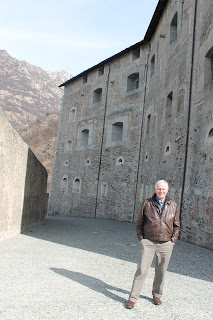To climb up the mountain to
Forte di Bard, they have
installed a series of 4 state-of-the
art external glass lifts with an
unhindered 360° view on all
sides to let us enjoy the scenery.
Estela is relieved that we can us the elevators,
while enjoying the view of the town under her
feet.
The view of the river that goes
parallel to the Via Francigena,
and the how both the Via and the
river seem to cut through the
mountains, forming the
Val D'Aosta.

Estela is at the entrance level of the fort, with
a view of the Val D'Aosta in the background.
Imagine this valley several thousands of years
completely covered by a glacier moving
through and cutting its way through the
granite mountains.
Fort Bard won its place in history when on May 14, 1800, 400 Piedmont and Austrian troops stopped Napoleon Army of 40,000 French troops that were planning a surprise attack on Turin and his subsequent campaign on the Po River Valley. Napoleon was furious that the factor of surprise had been lost, and he order the fort razed to the ground.
Fort Bard was later rebuilt as a defense against any future French invasions.
Fort Bard eventually became a prison.

Estela tries out the prison cell
that measures a mere 3 by 6
feet.
The main entrance to the castle
goes over a moat, but there is
no evidence that there was a
cross bridge-
Napoleon troops sieged the
Forte di Bard in 1800.
The river, the modern toll-highway and the town
of Bard behind me.
Side view of the Fort.
The bridge over the moat at the main entrance.
Nearby mountains were still covered by snow in
March.
Flagstone roof of a building that
nowadays is the ticket office.
Bronze sculptures.

















No comments:
Post a Comment